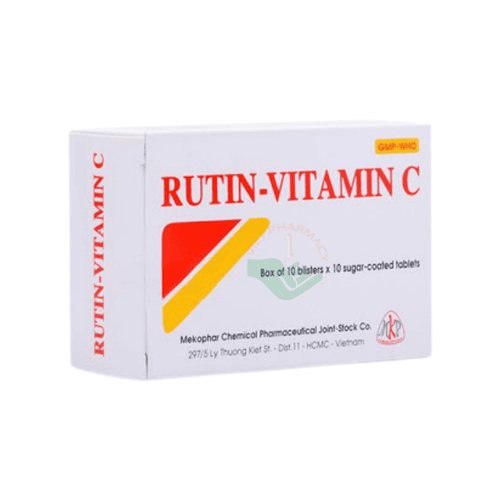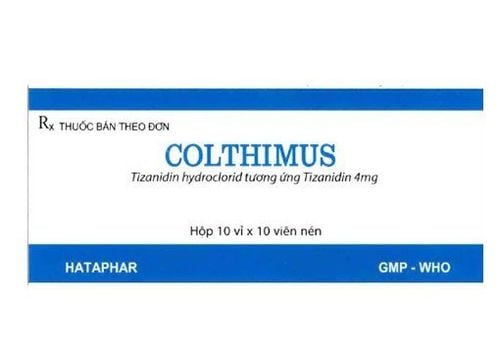This is an automatically translated article.
Nimovac is indicated in the treatment of bleeding and ischemic heart disease, causing a number of neurological disorders, circulatory failure, ... Let's learn the use of Nimovac through the article below. .
1 What is Nimovac?
Ingredients: Each bottle of Nimovac - V contains:
Nimodipine 10mg. Distilled water for injection is sufficient. Dosage form: Nimovac - V is prepared in the form of an infusion solution.
Manufacturer: Pharmathen S.A - Greece.
Packing: Each medicine box includes 1 bottle of 50ml + PE infusion device.
2. Uses of Nimovac
2.1 Effect of the drug Nimovac - V Nimodipine is a dihydropyridine calcium channel blocker with preferential action on cerebral blood vessels. Nimodipine increases cerebral perfusion, especially in poorly perfused areas, by dilating the arteries. The drug is rapidly absorbed after use. The volume of distribution of Nimodipine is 0.9-2.3 l/kg. The clearance of the drug Nimovac - V is 0.8-1.6l/g/kg. Nimodipine is 97-99% bound to plasma proteins. Nimodipine is first metabolised by the liver. The Cytochrome P450 3A4 system plays a major role in the metabolism of Nimodipine. Nimodipine is eliminated as metabolites, mainly by dehydrogenation of the Dihydropyridine ring and by O-demethylation. Oxidative ester cleavage, hydroxylation of 2- and 6-methyl groups, and glucuronidation as a conjugation reaction are other important metabolic steps. Nimovac - V is eliminated largely as metabolites. The metabolites of nimodipine are eliminated approximately 50% by the kidney and 30% by the bile. And only 1% is excreted in the urine as unchanged drug. 2.2 Indications Nimovac-C is indicated for use in the prevention and treatment of patients with subarachnoid hemorrhage experiencing ischemia due to vasospasm.
2.3 Dosage - How to use Nimovac - V Dosage:
Patients with subarachnoid hemorrhage:
In the first 2 hours, use a dose of 1mg/h (5ml Nimovac-V solution). If well tolerated, no significant decrease in blood pressure, increase the dose after 2 hours to 2mg/h (10ml Nimovac-V solution). Patients under 70 kg or unstable blood pressure or impaired liver function: a dose of 0.5 mg/h should be started. Take the drug continuously for at least 5 days and not more than 14 days. Treatment must begin as soon as possible. Usage:
Nimovac - V is used by intravenous infusion, so the drug is only used when prescribed by a doctor and manipulated by qualified doctors.
Nimodipine injection contains Ethanol (20%) and is therefore completely incompatible with lipid emulsions. This must be taken into account during the infusion.
When administering Nimovac-V into a peripheral vein, it is also necessary to infuse Glucose 5% or Sodium chloride 0.9% through the same catheter with a Y-shaped connecting tube to dilute and prevent thrombophlebitis due to ethanol.
Nimodipine is highly adsorbed on PVC, so PE tubing must be used instead.
Treatment in case of overdose:
Manifestations of an overdose of Nimovac - V injection are often very serious, when you see a patient with abnormal health symptoms, it is necessary to stop using the drug, call the treating doctor to have suitable solution
3. Nimovac side effects
Some undesirable effects that patients may experience when treated with Nimovac-V are:
Common:
Headache. Low blood pressure, fast or slow heart rate. Nausea, bloating, diarrhea. Itching, thrombophlebitis. Increase Transaminase, increase alkaline Phosphatase in the liver. Uncommon:
Dizziness . Extrasystoles, sweating. Decreased platelets. Increased serum creatinine and blood nitrogen. Rare:
Blushing. Bowel obstruction.
4. Notes when using Nimovac
Contraindications
Hypersensitivity to any component of the drug. Patients during or within one month of myocardial infarction, unstable angina, acute porphyria (a rare inherited blood disorder). Notes and cautions
Before administering the drug, it is necessary to disinfect the injection site, disinfect the hands of the injector to avoid infection.
When injecting intravenously, most of the drug must be withdrawn slowly to avoid air entering the blood vessels, causing dangerous embolism to the patient's life.
Within 30 minutes after injection, it is necessary to monitor the patient to ensure timely notification to the doctor for treatment if any unusual manifestations occur.
Check the expiration date before injecting, if expired, absolutely do not use. Withdrawing and handing over expired drugs to experts.
Before use, it is necessary to check whether the ampoule is intact, check the color and clarity of the injection solution, if there are particles in the solution visible to the eye or the color changes, absolutely do not use.
During infusion, observe the infusion in the bottle. If cloudiness, crystallization, discoloration or other unusual signs are observed, the infusion should be stopped immediately.
Caution in pregnant women and nursing mothers
Pregnant women only use when absolutely necessary.
According to studies in white rats, Nimodipine and its metabolites are excreted in the milk of lactating rats. Although it is not known whether the drug is excreted in human milk, the mother should not breast-feed when indicated for use.
5. Drug interactions
Concomitant twice-daily administration of 30mg Nimodipine and 20mg of the antidepressant Fluoxetine to elderly patients resulted in approximately 50% higher plasma concentrations of nimodipine, marked reductions in fluoxetine levels, while the active metabolite its unaffected.
Nimodipine is metabolised via the Cytochrome P450 3A4 system, located in both the intestinal mucosa and the liver. Although no formal interaction studies have been performed to investigate a potential interaction between nimodipine and the cytochrome P450 3A4 inhibitor, the possibility of drug interactions and increased nimodipine plasma concentrations cannot be excluded. .
After co-administration with the following inhibitors of the Cytochrome P450 3A4 system, blood pressure should be monitored and, if necessary, dose adjustment of Nimodipine should be considered:
Macrolide antibiotics (eg Erythromycin). Anti-HIV protease inhibitors (eg ritonavir). Azole antimycotic (eg Ketoconazole). Nefazodone . Nimodipine may enhance the hypotensive effect of concomitant antihypertensive drugs, such as:
Diuretics. Beta blocker group. ACE inhibitors. Other Calcium Antagonists. Alpha-adrenergic blocking agents. PDE5 inhibitors. Renal function may be impaired if potentially nephrotoxic drugs (eg, Aminoglycosides, Cephalosporins, Furosemide) are given concurrently and also in patients with renal impairment. Renal function must be carefully monitored in such cases and if there is deterioration, treatment should be discontinued. Animal studies have shown that when nimodipine and zidovudine are administered concurrently, the AUC for zidovudine is increased, and the volume of distribution and clearance rate decrease. Concomitant use of cimetidine or sodium valproate may lead to an increase in plasma concentrations of nimodipine. Drinking grapefruit juice while using Nimodipine for treatment may lead to increased plasma concentrations of Nimodipine due to inhibition of the oxidative metabolism of Dihydropyridine.
6. Preservation
Store at room temperature, in a cool, dry place. Avoid exposing the solution to direct sunlight. Do not store in freezer or refrigerator. Store in sealed packaging to avoid damage and breakage. If the packaging shows signs of damage, it must be discarded. Do not change the packaging to contain the medicine. Keep out of reach of CHILDREN.
Please dial HOTLINE for more information or register for an appointment HERE. Download MyVinmec app to make appointments faster and to manage your bookings easily.













